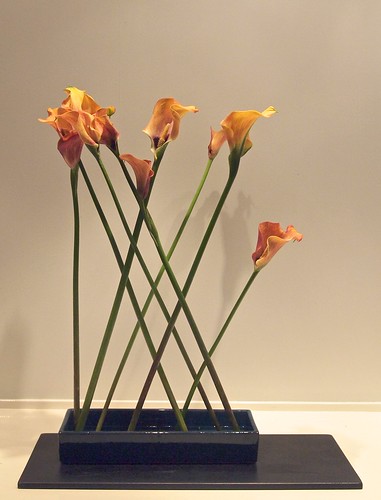Flowers only, straight and curved lines, mass and line.
Ishu-ike, abstract freestyle, moribana.
Ishu-ike, abstract freestyle, moribana.
I found these magnificent Cala lilies at the market square today. They were exactly what I needed. Nice fall colours and long, ferm stems - perfect fore the challenge I got for this weeks class at my ikebana teacher: To make a variety of mass and line designs using the same material.
Image may be NSFW.
Clik here to view.
Flowers only, straight lines, mass and line.
Ishu-ike, abstract freestyle, moribana.
Clik here to view.

Flowers only, straight lines, mass and line.
Ishu-ike, abstract freestyle, moribana.
Mass and lines are two of the fundamental elements in ikebana. By showing different kinds of lines, basically straight and curved, in contrast with massed materials a peaceful balance is achieved.
In the teachings of the Sogetsu School it is usually said that the third fundamental element is colour. Christopher James, a friend of mine who is teaching ikebana in Melbourne, argues that it makes even more sense to exchange colour with space when it comes to the essentials of ikebana. The importance of space in Ikebana is, according to him, growing from the early Buddhist tradition of the triptychs, with the middle screen always depicting a “sacred” empty space. So, space has a traditional cultural connection to spirituality in Japan and is extremely important in ikebana. Maybe even to the extent that we should say "mass, line and space" rather than "mass, line and colour".
I find it to be an interesting observation that points out an important thing to keep in mind. When you think about it, the arrangements in this blog post are actually even more about the open space created between the lines, than the actual lines.
In the teachings of the Sogetsu School it is usually said that the third fundamental element is colour. Christopher James, a friend of mine who is teaching ikebana in Melbourne, argues that it makes even more sense to exchange colour with space when it comes to the essentials of ikebana. The importance of space in Ikebana is, according to him, growing from the early Buddhist tradition of the triptychs, with the middle screen always depicting a “sacred” empty space. So, space has a traditional cultural connection to spirituality in Japan and is extremely important in ikebana. Maybe even to the extent that we should say "mass, line and space" rather than "mass, line and colour".
I find it to be an interesting observation that points out an important thing to keep in mind. When you think about it, the arrangements in this blog post are actually even more about the open space created between the lines, than the actual lines.
Image may be NSFW.
Clik here to view.
Flowers only, straight and curved lines, mass and line.
Ishu-ike, abstract freestyle, moribana.
Clik here to view.

Flowers only, straight and curved lines, mass and line.
Ishu-ike, abstract freestyle, moribana.
The exercise of this blog post exemplifies in a good way that all parts of the plant is equally important in ikebana designs. It's not all about the flower part. In these arrangements the shapes of the stems are the main feature.
A couple of the stems had double sets of petals (I've never seen that before on a Cala), which helped a lot when it came to fixing the flowers against each other.
A couple of the stems had double sets of petals (I've never seen that before on a Cala), which helped a lot when it came to fixing the flowers against each other.
Flowers only, straight lines.
Ishu-ike, abstract freestyle, moribana.
Ishu-ike, abstract freestyle, moribana.


